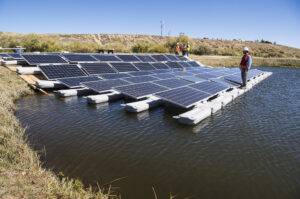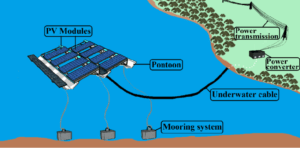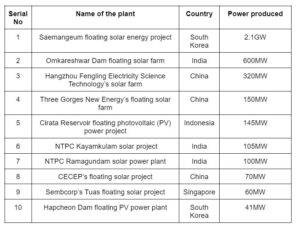The solar panel concept is quite simple, helping people with converted energies from the Sun. Over the years, everyone has become accustomed to the same, and one can find it in their surroundings. To save energy and taxation, people are installing solar panels on the roof of their houses. You can find one on the empty grounds beside the airport, agricultural lands, and regular parking lots. Now the question stands “is there any place where we cannot find a solar panel?” So far, it was the reservoir, which is now covered by floating solar panels or Floatovoltaics.
Floating solar panels – Overview
Floating solar panels, or Floatovoltaics, are the latest to slow down climate change. You will come across these panels mounted over another floating structure on a water body – reservoirs, irrigation canals, quarry lakes, and tailing ponds.

So far, Japan, India, France, China, South Korea, the USA, the UK, and Singapore have a small number of floating solar power plants within their boundaries. Each installation comprises panels over a floating platform anchored with cables at the bottom.
Features of a floating solar power plant
Floating solar panels together form a solar power plant floating on the water surface. Here is a list of features in a floating solar power plant that you can witness:
- The entire plant frame is rust-resistant and made of alloy, ensuring longevity in harsh weather conditions.
- The outer body is sturdy and buoyant, capable of carrying heavy loads.
- Also, other characteristics include a dustproof, humidity-resistant, and lead-free solar panel.
Floating solar power plant – Basic Structure

Evident from the name, floating solar panels or Floatovoltaics are always above water. That way, it is necessary for these structures to have a steady base and connecting channels. Here is a list of all the components you will find within.
- A floating structure: As previously discussed. The solar panel does come with a floating base, termed a Pontoon. The structure is sturdy (it can carry heavy loads), has enough buoyancy, and can stay afloat.
- Mooring arrangement: It is essential to ensure the floating structure is in place. For that, a permeant facility known as mooring does offer adequate support. Its purpose is to put a halt to the floating frame. An anchor mooring connects the floating structure to the bottom of the shore, eliminating further movements.
- Cable system (underwater): A waterproof cable connects the solar panel to the shore.
How does Floatovoltaics work?
The floating solar panels or Floatovoltaics keep still on the water’s surface, collecting sunlight throughout the year. Underwater cables are affixed to the structure, enabling seamless power movement to a transmission tower.
Size and power-generating ability are deciding factors for the price of Floatovoltaics plant. On average, the amount stands at 80 to 120 million US$ for a plant producing 100MW of electricity.
Advantages of installing Floatovoltaics or floating solar panels- Case study
Water-based Floatovoltaics are cooler and up to 5% more efficient than solar panels on land. Also, a study in 2021 does prove that California can save 63 billion gallons of water from evaporating every year by covering 4000 miles of the canal system with floating solar panels.
Also joining the list, we have the USA. There are a total of 25,000 sq miles of water. As per the study, if the USA decides to cover around 30% of its area, it would be able to generate energy up to 1900 terawatt hours. Next in line, there is
- China – 1100 terawatt hours
- Brazil – 865 terawatt hours
- India – 766 terawatt hours
- Egypt stands at 66 terawatt hours and can save 200 billion gallons of water from evaporation. Moreover, countries like Sudan, Zimbabwe, and Myanmar have the potential to conserve water and generate Floatovoltaics power.
Another study in 2023 highlights the advantages of floating solar panels over reservoirs, compared to the ones installed on the land. The team went for analysis of reports from reservoir databases. Then they did calculate the amount of energy that could possibly be generated by covering 30% of 114,555 reservoirs. The administrator can think of developing local power plants based on the proximity between the reservoirs and the localities. 6,256 cities/communities and 154 metropolises across 124 countries can benefit from such an approach. Also, covering the water bodies with floating solar panels reduces the evaporation rate.
Advantages of Floatovoltaics in general
Apart from the ones mentioned above, there is more to the list:
- With floating solar panels covering the water area, such as lakes, dams, and freshwater, the important land area now can be utilized for farming and cultivation.
- Also, floating solar panels eliminate algae formation over the still water bodies. This helps with the hygiene part, enabling sustainable living.
- The efficiency levels of solar panels on land diminish with time under the effect of extreme exposure to the Sun. Whereas those on the waterbodies last longer, as the water underneath does offer a cooling effect. Thus protecting the solar panels from absolute heat.

Floating solar panels making floating solar power plant are quite effective and energy efficient in the long run. However, certain conditions, like a shortage of skilled labor, mandatory use of top-notch materials, continuous climate change, and huge installation charges, hamper regular use. Even after so many obstacles, countries are moving towards a sustainable approach and accepting floating solar power plants.



